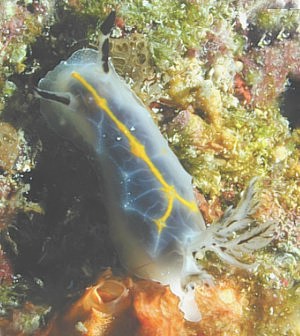Halgerda toliara? from Madagascar
January 20, 2001
From: Leif Abrell


Dear Dr. Rudman and forum participants:
I would like to share my photos of a nudibranch I photographed underwater on a sponge/rock substrate approximately 10 meters deep in NW Madagascar in April, 2000. I've spent a fair amount of time looking at nudibranch pictures in order to make a tentative id. The closest match I can make so far, is to the Halgerda toliara photos posted on the Sea Slug Forum. I look forward to receiving anyone's ideas about the identification of this nudibranch.
I am a bioorganic natural products chemist doing post doctoral work in the Chemistry Dept. at Columbia University in NYC. I am interested in marine invertebrate natural products, including the chemistry of opisthobranchs. I have photos of a few other nudibranchs from Madagascar which I will send to the Forum. They can be seen at http://www.columbia.edu/~la202/Mad-opisth2000.html
Leif Abrell
lagartica@hotmail.com
Abrell, L., 2001 (Jan 20) Halgerda toliara? from Madagascar. [Message in] Sea Slug Forum. Australian Museum, Sydney. Available from http://www.seaslugforum.net/find/3569Dear Leif,
I think your Halgerda is a bit of a problem. Unfortunately a number of species have recently been described from very few, in some cases only one, specimen. This means we have little idea of their colour variability. For example Halgerda dichromis was described from a single specimen and one of its chracteristics was that it lacked the ridges found in most species of Halgerda. However from the photos we now have from Valda Fraser it seems that this species is quite variable and it can have quite pronounced ridges.
Which gets me in a round about way to your animal. It certainly looks like Halgerda toliara, which also seems fairly variable in colour, and was originally described from Madagascar, but the colour of the gills and rhinophores are different. In your animal the rhinophore club is apparently black and the white stalk has a black line up the posterior midline. The dorsal side of the gills is lined with black. In 'typical' H. toliara there is no black line on the rhinophore stalk and the distal half of each gill seems to be all black. Your animal has some similarities to Halgerda formosa, but there is no sign of black spots on the mantle.
My feeling is that it might be a colour form of Halgerda dichromis. The gill and rhinophore colour fits, and in Valda's photos [see messages below yours on this page] the yellow median line often forks posteriorly, sending a branch down each side of the gills. However this is just a guess. You may have another unnamed yellow and black species or you may just have a variation of a species we don't know very much about at present.
I look forward to any contributions you can make concerning nudibranchs and their chemicals. It is a fascinating field of study.
Best wishes,
Bill Rudman
Related messages
-
Colour forms of Halgerda dichromis mating
From: Valda Fraser, March 31, 2009 -
Halgerda dichromis? from South Africa
From: Valda Fraser, August 8, 2000 -
A variety of Halgerda dichromis?
From: Valda Fraser, July 10, 2000 -
Halgerda dichromis from South Africa
From: Valda Fraser, March 12, 2000 -
Re: Halgerda dichromis
From: Valda Fraser, December 1, 1999 -
Colour variation in Halgerda dichromis
From: Valda Fraser, November 24, 1999 -
Halgerda dichromis? from South Africa
From: Valda Fraser, November 19, 1999
